Fishing With Beads: 5 Guide Tips For More Fish
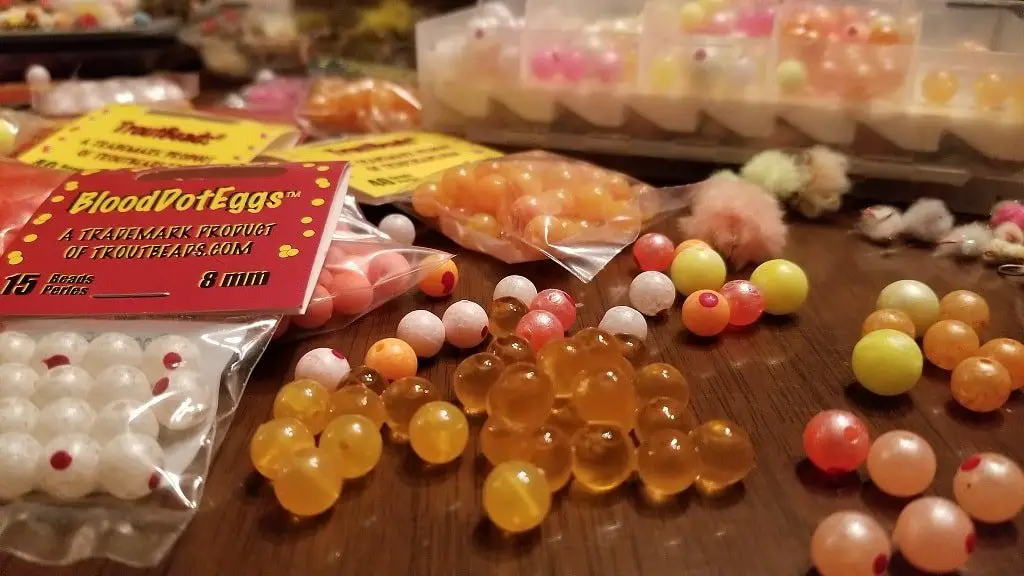
Fishing with trout beads is a great way to catch more trout, steelhead, and salmon in rivers because beads imitate the fish eggs that trout and steelhead love to eat.
I have been using beads for over 20 years, and they are one of my most effective baits. I will share my best trout bead types, sizes, colors, and rigging methods, along with a tip on changing trout beads quickly and easily.
We may make a small commission from some of the links on this website, which is at no cost to you. I appreciate your support.
Three Types Of Beads
There are three main types of beads.
- Soft Beads: Soft beads are rigged straight onto the hook.
- Plastic Beads: Plastic beads are hard and are using specially rigged so the bead is on the line 1 to 2 inches up from the hook.
- Glass Beads: Glass beads are a favorite among many anglers because they are hard, heavy, and sink.
- Stone: I have recently seen stone beads.
Trout and steelhead beads are hard and come with a very small hole in them so that they can be slid up the line and fastened onto the line and not onto the hook.
Bead Sizes
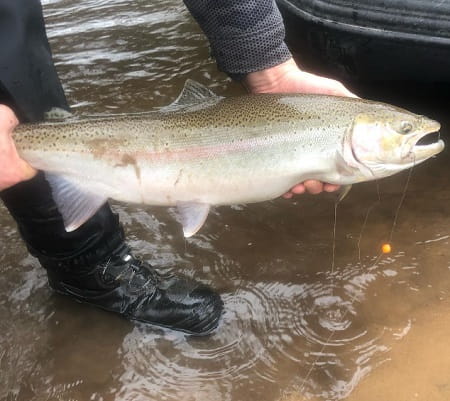
Beads come in 4 different sizes, which are good for clear to dirty water situations.
A 6mm bead is about the size of a typical egg from a brown trout or rainbow trout, its small.
An 8mm bead is the size of a typical salmon egg.
Myself and many other anglers tend to use the 8mm beads the most where salmon exist. The 8mm size is good for clear to slightly colored water conditions and in faster water situations.
The larger 10mm and 12mm trout beads get seen better in faster flows and when the water is dirtier, and therefore get picked up by the fish more often.
I will drop down to the smaller 6mm beads under very clear water conditions or during the spring when the steelhead or rainbow trout are spawning.
Best Bead Colors
One study found that over the winter, the main food item for steelhead was the eggs of other salmonids, and many of those eggs get very lighter in color, which might be why I do so well with white and peach colored beads in the winter.
The best steelhead bead colors are often shades of yellows, oranges, and pinks, however, the colors that will work the best will depend on the clarity of the water and the light conditions as well as time of year and the spawning cycle of other fish.
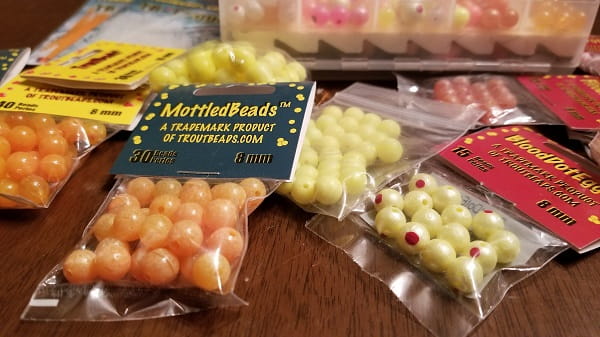
Trout bead colors can also come with some unique patterns.
Common patterns are mottled trout beads which give the bead a cloudy or milky look.
Some trout beads also come in what is called blood dot beads, which have a red painted dot on the bead, which is thought to attract the fish.
Best Hooks For Beads
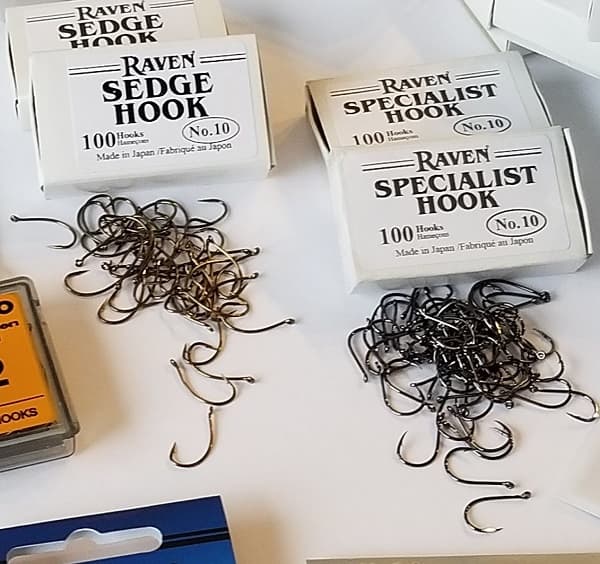
Fishing with trout beads requires the right hook size and shape, and some of the best hooks for fishing with beads are the Raven Specimen hooks.
I use the same hooks for steelhead as I do for trout, but I change the sizes of hooks based on the size of the trout bead, the speed of the current, the depth of the spot, and the clarity of the river.
I use hooks between a size eight and a size twelve for trout. I rarely go smaller than a size 12, and I mostly use a size 10 for steelhead, and size 8 for salmon.
If I had to choose one hook size for trout, I would go with a size 10 Raven sedge hook because it is light and stealthy.
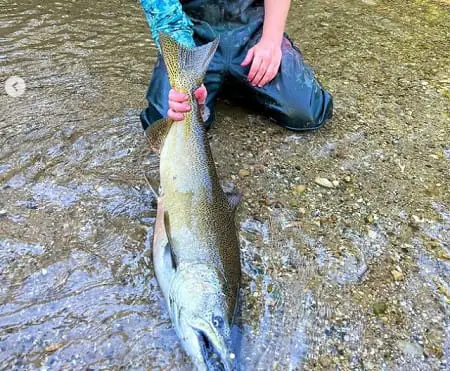
However, the Raven Specimen hook holds onto fish better, so I use it when a stealthy hook is not required or when a stronger hook is needed for steelhead and salmon.
Check out the best hooks that I use, which are also tested and proven to work well with steelhead beads. See them on my Best Hooks page.
Some of the best hooks for beads are:
- Raven Sedge Hook – get them at FishUSA.com – HERE.
- Raven Specimen – get them at FishUSA.com – HERE.
- Gamakatsu – get them at FishUSA.com – HERE.
- Blackbird – get them at FishUSA.com – HERE.
Methods For Fishing With Beads
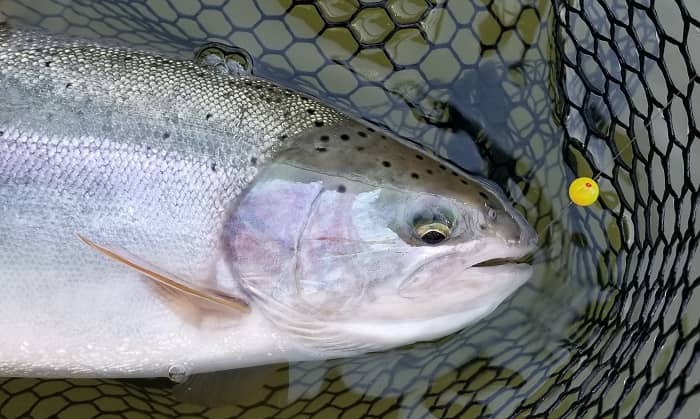
The main methods used for fishing beads are:
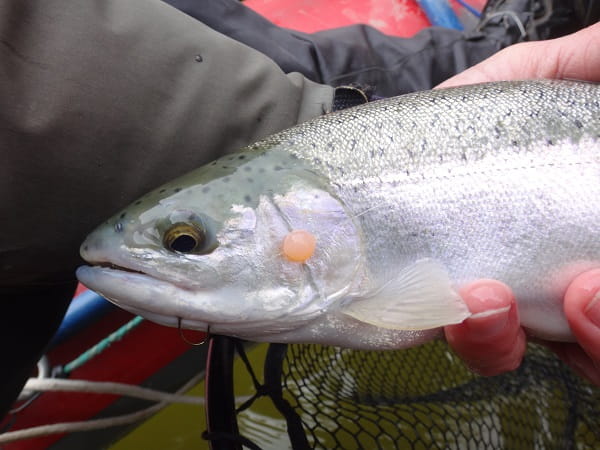
I only fish beads in rivers. I have found that fishing beads in lakes is not very good and that you are better off using better baits that are more suited for lake fishing.
If you want to see how well beads fish when compared to the more popular spawn sacs, check out this awesome video from SBS Outdoor Action, where John from Gent Bent Guide Service competes to see what works better for steelhead.
You might be surprised. Watch Now! Winter Steelhead BOBBER DOWN CHALLENGE! – Beads vs. Bags (Surprising Results)
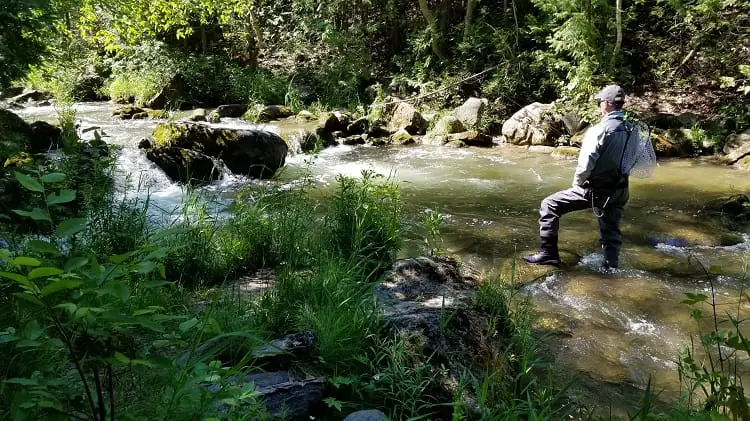
Plastic Beads
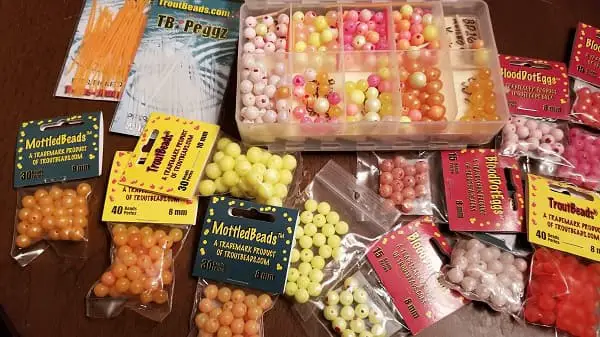
Plastic beads are by far the most common types of beads because they are readily available and they are cheaper than glass beads.
I use the Trout Beads brand with great success and mostly use the 8mm size.
Plastic beads also come in many great colors and three of four good sizes.
I prefer the plastic beads on rivers that are not too deep because they don’t need to get down as deep. This is helpful because you don’t want to drag the bottom with your trout bead.
The best plastic beads are from a brand called TroutBeads, and you can get the best price on individual packs at FishUSA- Here or get a variety pack at FishUSA – HERE
Clear Water Use: 6mm and 8mm | Medium Clear Water Use: Size 8mm is best | Dirty Water Use: Size 10mm or 12mm |
Peach Roe | Egg Yolk | Chartreuse |
Salmon | Natural Roe | Hot Cherry Roe |
Glow Roe | Orange-Clear | |
Peach Fuzz | Gold Roe | |
Apricot Swirl | Mottled Natural Roe | |
Gold Roe | Pink | |
Milt Roe | Cerise |
Glass Beads
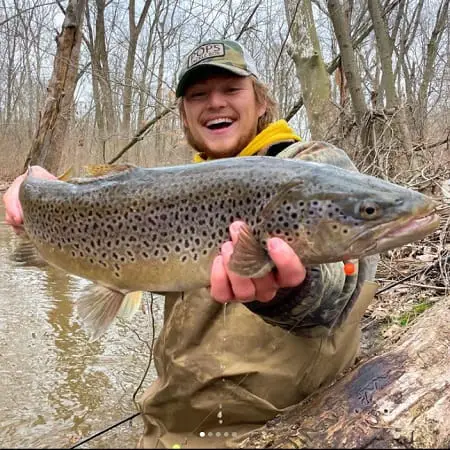
Some anglers swear that glass beads are much better at catching trout, steelhead, and salmon than plastic trout beads, and in my opinion, glass beads probably are better than plastic beads, but only because of a fault in the angler’s presentation.
Glass beads are much heavier than plastic beads so they get down fast.
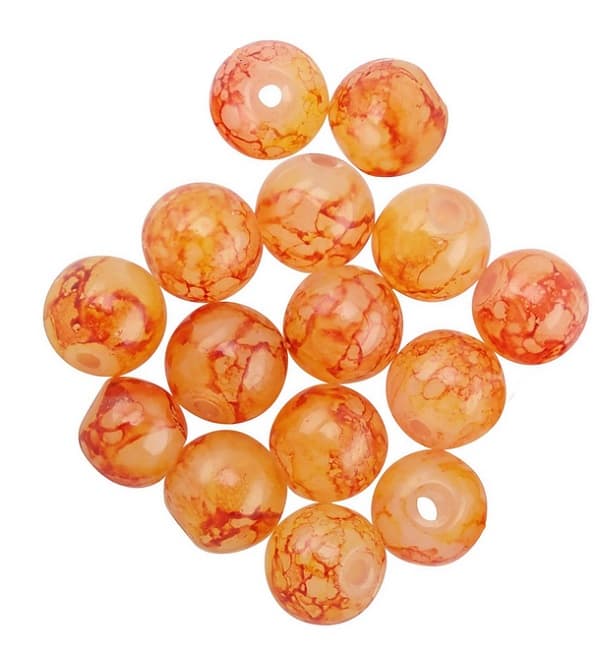
I do not believe that glass beads are actually better than plastic beads for any other reason than they sink and get into the strike zone faster, and they stay there longer.
For many anglers, this is a good thing. I prefer to properly weight my leader and use lighter beads.
The best trout beads on the market come from CreekCandy Bead Company, and you can get them at FishUSA.com.
When fishing beads, I change my sizes based on the conditions. See the chart below for sizing and the best colors to use.
The Best Glass Beads Are:
Clear Water | Medium Clear Water Size: 8mm and 10mm | Dirty Water - 12 inches or less vizability Size: 10mm or 12mm |
Clearwater Candy Corn | Natural Honey | Frosty Chartreuse Hyper UV |
Clearwater Atomic Peach | Tequila Sunrise | Blood Shot Embryo |
Clearwater White Widow Hyper HD UV | Blood Shot Candy Corn | Clearwater Atomic Chartreuse Hyper HD UV |
Frosty Brown Roe Hyper UV | Bow Roe Hyper UV | |
Natural Sucker Egg | Toxic Berry Hyper UV | |
Blood Shot Candy Corn | Trout Crack Hyper UV |
Securing Beads To The Line
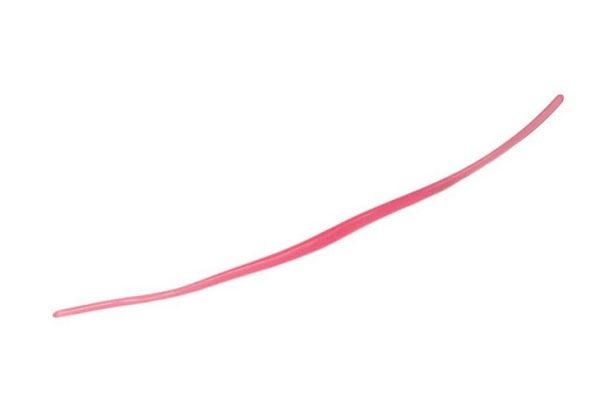
You can secure the beads to the line using what are called rubber bead pegs. You can also secure the bead with a toothpick, with bobber stops, or even with small rubber bands.
For proper bead placement, see below in the bead rigs section.
Check out the rubber band method on YouTube. If you like this method, you will need this banding tool from FishUSA.
There are also some knots that anglers will use to secure the beads to the line. You can see the bead knot method on YouTube
I prefer the TroutBead pegs from FishUSA.com over all other methods for securing beads to the line because they allow the bead to slide down when a fish has it in its mouth for a better hook set.
Soft Beads
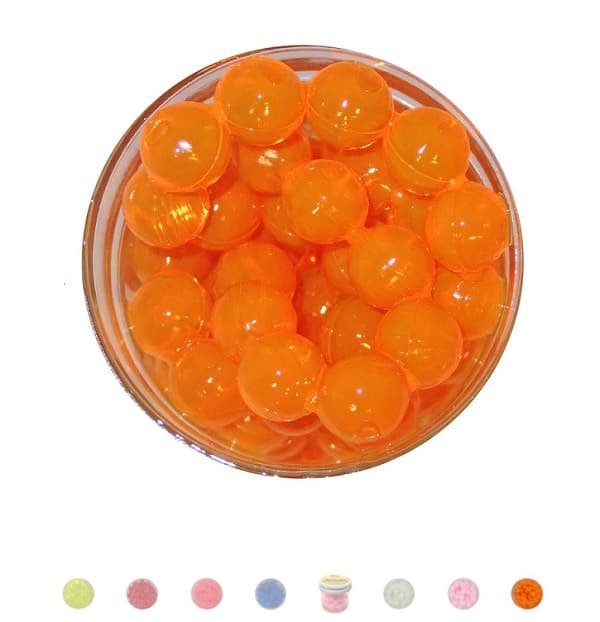
Soft beads are made out of softer plastic or rubber, and they can also be a good bait for catching catch trout, steelhead, and salmon.
Soft beads go on the hook instead of on the line and can be removed and changed more easily than hard beads.
Trout and steelhead may hold onto soft beads longer, but they may also see the hook easier through the translucent bead and then avoid eating the soft beads.
There is a way to attach a soft bead on the line similar to how we rig the hard beads. You can see how to do this on YouTube – HERE or for an easier method, see this video – HERE
Soft beads are not used as often on the rivers because most guys feel that they’re not as effective as hard beads. However, soft beads can be very effective, and they are worth a try.
Death Roe Beads: Premium Soft Beads
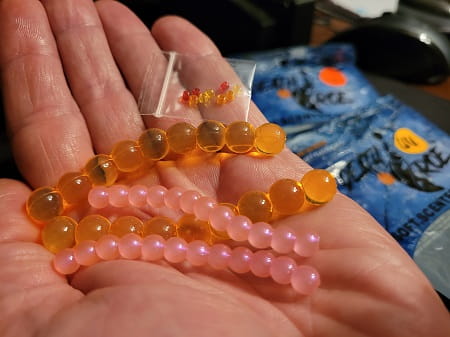
A very popular soft bead that I have used and like a lot is the Death Roe Soft Beads.
These scented soft beads come with micro hard beads for a special setup.
You can see the small package of microbeads in the image. See that bead setup HERE.
Some of the best soft beads are:
- Berkley Gulp! Alive! Floating Salmon Eggs – get them at FishUSA.com or at Bass Pro Shops – HERE.
- Berkley PowerBait Magnum Power Eggs – Get them at FishUSA.com – HERE.
- Magic Salmon Eggs – Get them at Bass Pro Shops – HERE.
- Atlas Plastic Eggs – get them at FishUSA.com.
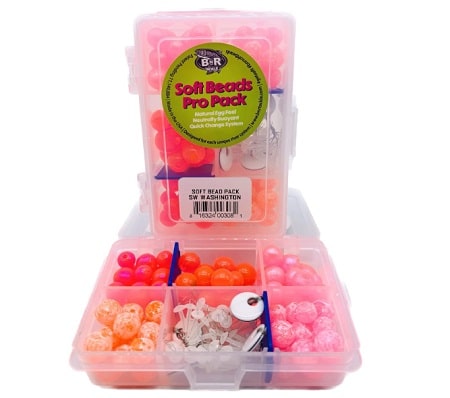
BnR Tackle Soft Beads Pro Pack
This is a great soft bead pack that comes with a quick change rig system that some guys really like.
These soft trout beads look like reel eggs, and they feel like them too. They are neutral buoyancy with a self-closing center hole for easy rigging.
How To Rig Beads: 3 Best Bead Rigs
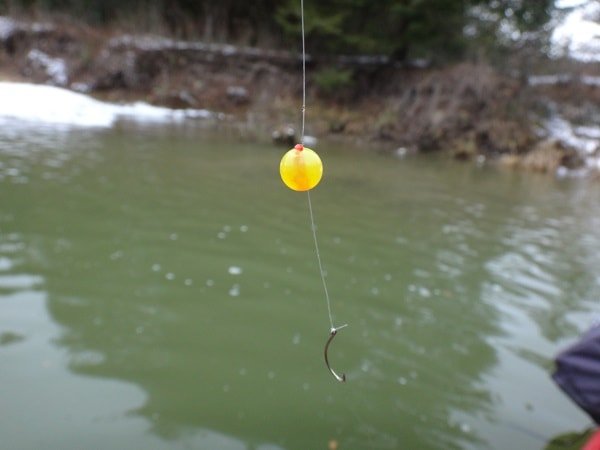
When bead fishing, I always position my bead 1.5″ to 2″ inches up from the hook for two reasons.
The reason for this is that the hook is less likely to be seen by the fish when it’s farther away from the bead, which means more hookups.
Also, as the fish tries to inhale the bead, the hook almost always gets caught on the outside of the lip, which self-hooks the fish and then decreases my chances of losing a fish to them spitting the hook out too fast.
If I go shorter than 1.5 inches or with the bead touching the hook, I tend to find that the hook goes too deep in their throat, which makes it harder to release the fish unharmed.
Single And Double Bead Rigs
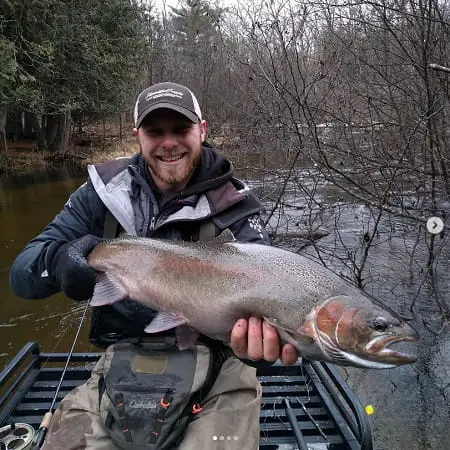
I will use a single bead rig in water that is three to eight feet deep, but when I fish water that is four to two feet deep, I will often use a double-bead rig so that I can cover the bottom and cover higher up in the water column.
With the double bead rig, I will often use two different bead colors to see which one the fish prefers.
If one bead is getting hit more often, instead of putting on two beads of the same color, I will keep switching the bead color on the one that doesn’t get hit until I find a color that they want. This way, I have two colors on the line that are hot colors. You could also run two of the same colors if you wanted to see if that works.
Standard Bead Setup
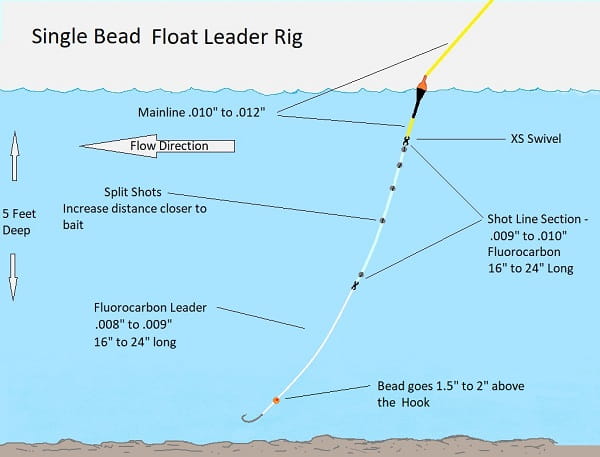
This is my standard single bead rig that I use when guiding for steelhead or for trout on very big or fast rivers.
For trout, I will drop down to a 3 to 6-pound leader section at the bottom, and for salmon, I will go up to a ten or twelve-pound test leader.
This is the same for the leader diagram below.
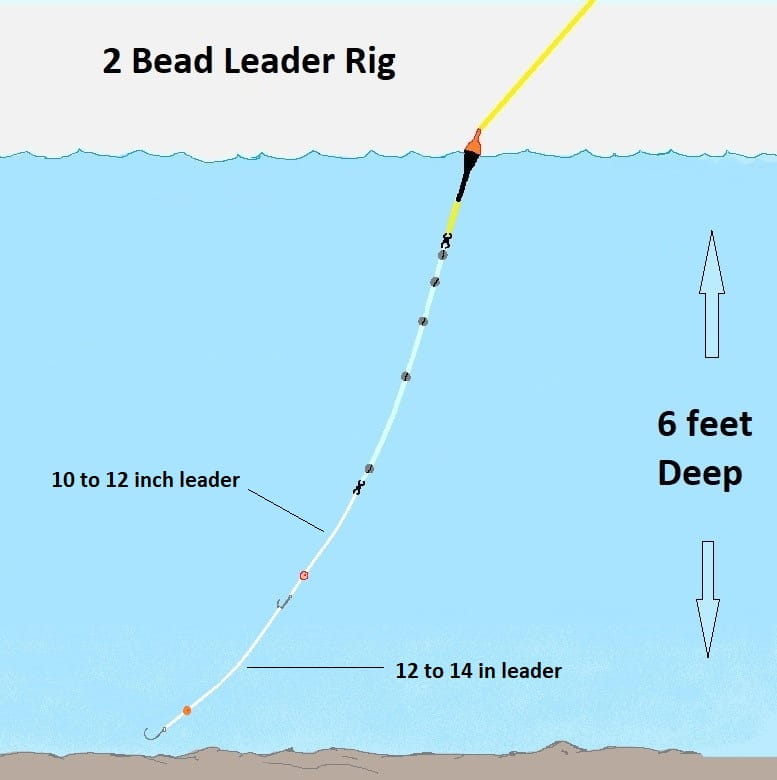
This is the two-bead rig that I use when I’m guiding.
You could add a bead and bait combination instead of two beads.
It is up to you to experiment with which bait goes where, but my rule of thumb is that my confidence bait goes on the bottom.
Trout Bead Setup Drift Fishing/Bottom Bouncing Rig
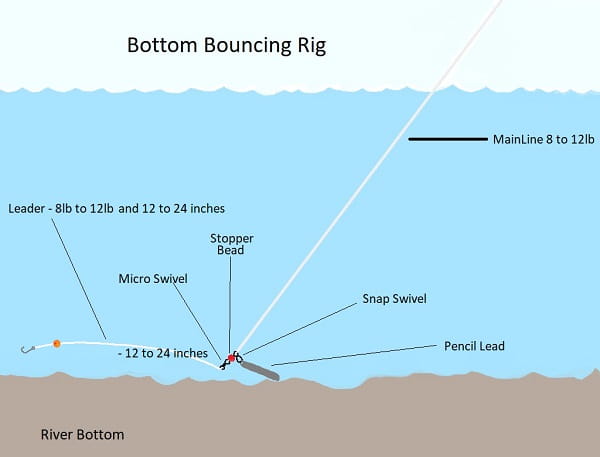
This is a traditional drift fishing/bottom bouncing rig that I use with beads in bigger, faster pools.
There are some other variations to set this up and to properly fish with it, which can be seen on my Bottom Bouncing page.
Shallow Water Bead Setup – Advanced Bottom Bouncing Rig
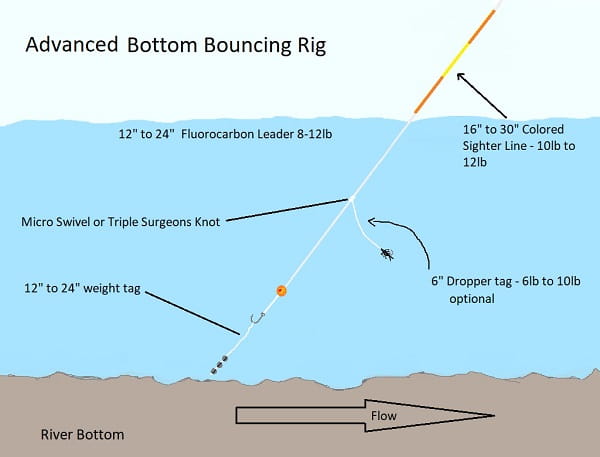
This is my most productive bead rig when I am fishing for trout or steelhead in smaller to medium-sized rivers where there is a lot of pocket water and shallow runs.
This bottom bouncing rig is an adaptation of an advanced nymphing setup used by myself and by world champion tournament fly anglers around the world.
This method is better than any other method I have used when fishing a bead in spots that are 12 inches to 3 feet deep.
Bead Fishing For Trout – Easy Guide Secrets.
Quick Change Trout Beads
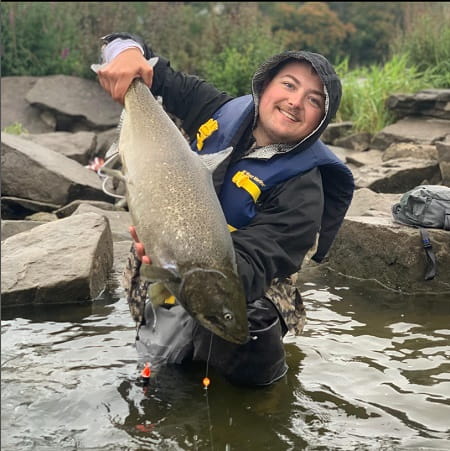
One of the big downsides to beads is that in order to change your bead you often need to cut the hook and bead off.
A pre-tied bead rig, also known as a bead leader, allows you to quickly make a change with only one knot.
I simply make up 10 to 20 pre-tied bead rigs when I’m at home, and I secure them to a rig holder like the Lindy Rig holder in the picture below. You can usually get the Lyndy Rig Holder at this link.
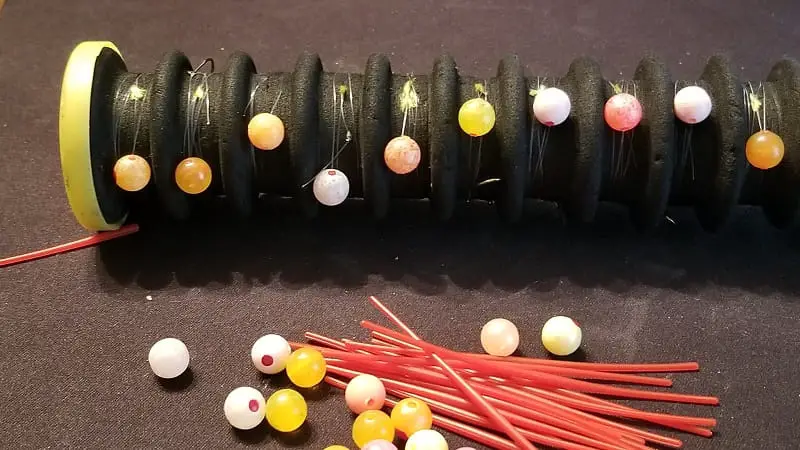
Bead Storage And Organization.
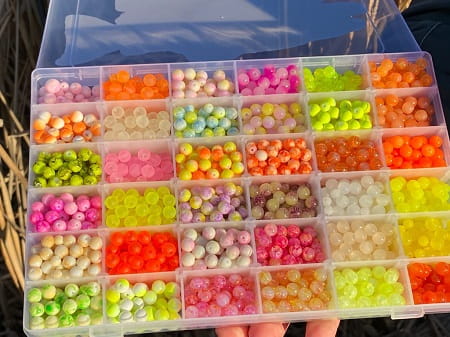
I have a ton of beads!
Lots of colors, sizes, and types of beads for all the different conditions. There is no way I could bring all my beads with me on a guide trip.
At home, I store all my beads in large bead boxes.
Bead Boxes
I put all my beads in a trout bead box. One of the best boxes is this large TroutBead box from Fish USA.com.
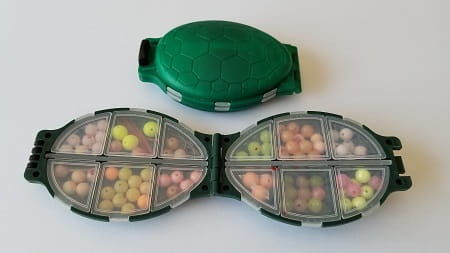
On the river, I only take what I call day boxes which is just enough of an assortment of beads to last a few days or more, and as the colors deplete, I just add more.
Setting The Hook Issues and Fixes
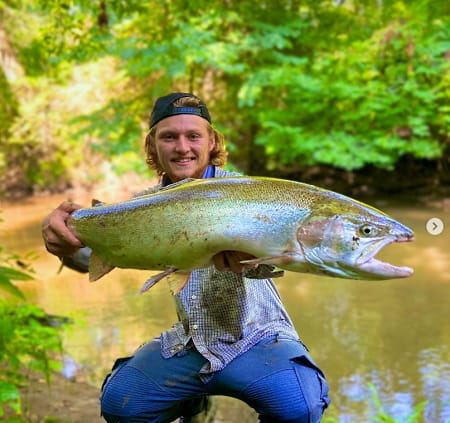
Some anglers find they miss bites or fish come off more often when using beads. I don’t have that problem, and I will tell you why!
First, understand this: Most of the beads that anglers use are as hard as a rock, and any fish that puts it in its mouth is going to spit it out fast. So, you need to SET HARD, and the hook FAST!!
This is the revised and shortened article. The full version includes all my tips and in-depth information on this topic, including
- Fix Hooking Issues: I discuss methods to fix common hooking issues.
- Four Reasons Why Anglers Have Fish Come Off – Tips on increasing your hooking percentage and how to ensure the fish stay hooked.
- Why Snag or Foul Hook Fish: I discuss the reasons why some guys tend to accidentally foul hook fish and how to prevent it.
- Fishing Beads In Lakes and Ponds – Why I do not recommend it.
See the in-depth full article HERE.
Tight Lines,
Graham
References:
- US Fish and Wildlife Service. Steelhead study
- Research Gate: Seasonal feeding habits, growth, and movement of steelhead trout in the lower Mokelumne River, California
- DFW – Study on salmon and steelhead overlap and winter holding

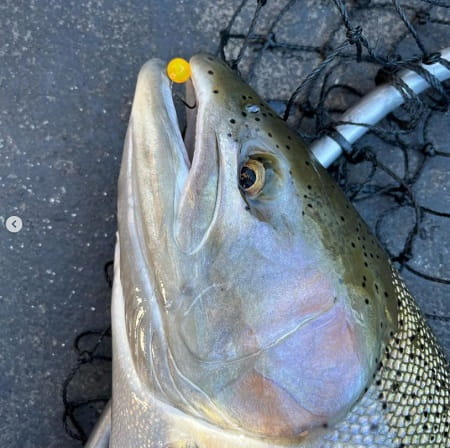
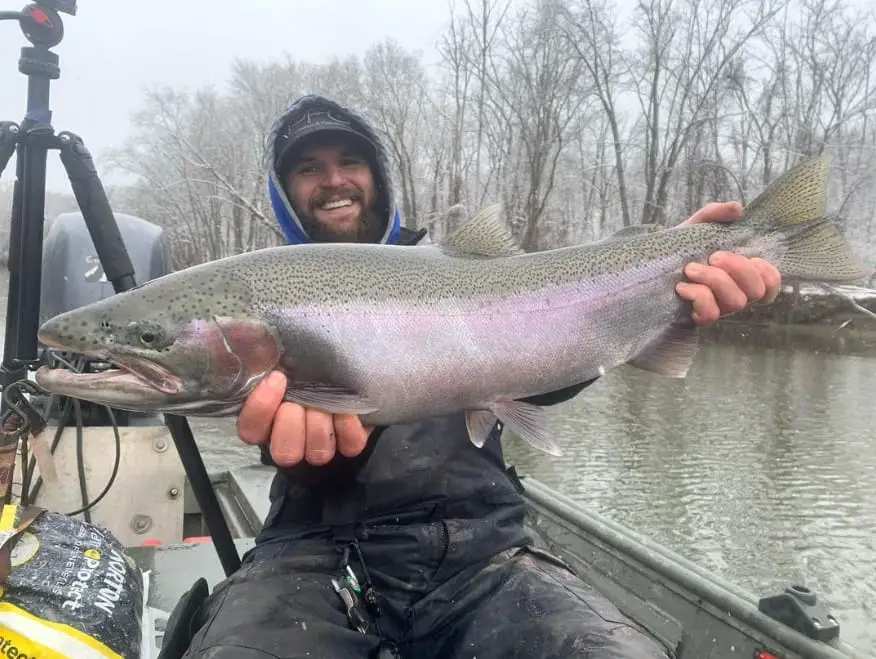
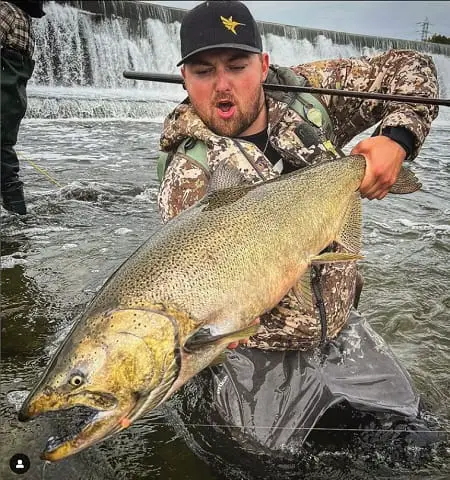
Where I trout fish at here in West Virginia is mostly lakes and the tailwaters
of dams. These are almost always stocked trout. Could you use this bead fishing methods in these locations? Also would I use the 6-12 mm beads for the same water conditions?
I have read a lot of your articles and they are very informative.
I am almost 72 and just got into trout fishing this year.
Hi Lonnie, Almost always what will work on wild trout will work on stocked trout and there is a chance that some fish would spawn in that tailwater current and the trout will be eating it so beads could be a good idea. If the water is very clear use 6mm and 8mm beads. I’m glad you liked the articles, there is more coming and I will be revising some of the old stuff to make it better. Good luck
Amazing information thank you so much for the time you put in!
Although this method has been very successful for me, I’ve stopped using it of late because of all the fish that come off. I hook a fish, fight it, and then, it’s gone. This doesn’t happen, btw, when I fish other styles, such as Euro. Reading your article made me think that perhaps it’s the hook I’ve been using. For fishing medium sized streams for medium to large trout, is the Raven sedge hook still your hook. of choice and could the reason for all my lost fish be the fact that I’ve been using TMC 2488 hooks in sizes 14-18?
Hey Alex,
This is not an uncommon problem for many anglers and it does sound like a hook issue. Be sure to have your hook 1.5″ from the bead. If the hard bead is too close or touching the hook it can sometimes prevent hook penetration or even pry the hook out. If this is the case, trying a soft bead might be a good idea.
If you are losing the fish during the fight it’s usually because your kook is tearing loose or you are giving them slack. If it’s tearing loose often you need a new type of hook.
A larger wider gap hook such as a #12 0r #10 Raven Wide Gape Specimen hook might be a better option, many of my guides have switched to that hook because they feel it holds better. I still use the Raven Sedge hooks often, but I’ll often use a size 8 or 10 with a bead. The size 16 and 18 hooks will not penetrate well and therefore are prone to ripping out easier.
The wider and the bigger the gap on the hook, the more flesh it grabs and the fish will stay on longer. If you see the upturned hook point on that Raven Specimen hook, that upturn tends to hold on better as well. This is why you will often see many of the high-end competition barbless fly hooks having an upturned point.
Hope that helps, Good luck.
Graham
Thanks for your reply, Graham.
Could you tell me if your #1 choice of hook when fishing 6mm beads for trout would be a 10 Raven sedge hook? If so, what knot would you use to attach the hook to your leader (I’m especially interested in whether you would snell the hook)?
Finally, thanks for the great website. There’s so much great information here!
Hi Alex,
I use the Raven Sedge hook or the Daiichi 1150 when I need a stealthy hook. This might be in low clear water or in very slow water when the trout or steelhead can see the hook or when they have plenty of time to investigate the bait, in which case they may see a bigger thicker hook.
If you want the best hook for hooking and holding fish, try the Raven Wide Gape Specimen hook or another similar wide gap hook.
Although I don’t normally use a snell knot, (I usually use a Double Davy, Improved clinch, or Trilene knot), a snell knot could be a good option and it may increase your hookups, or not. I may do a video on why or why not a snell knot could be better or worse but it’s too hard to explain in words. I would suggest doing a trial and error with the two knots to see which has the best hooking percentage and best holding percentage.
Good Luck.
Graham
I ordered Raven Sedge and Wide Gap hooks and my hookup ratio went way, way up. Thanks for the advice.
Now, I’d love to hear your thoughts on snelling vs. using a knot when fishing beads. A video or just a few words would be most welcome.
That’s Great to hear Alex,
Although I don’t normally use a snell knot, (I usually use a Double Davy, Improved clinch, or Trilene knot), a snell knot could be a good option and it may increase your hookups, or not. I may do a video on why or why not a snell knot could be better or worse but it’s too hard to explain in words. I would suggest doing a trial and error with the two knots to see which has the best hooking percentage and best holding percentage.
Good luck
Graham
I did some experimenting yesterday with a Raven Sedge hook. I normally snell the hook, but yesterday I fished a bit with the hook tied on with a Double Davy knot. Interestingly, the hookup and retention rate was about the same for both methods. I find that curious, since I imagined that a snelled hook should maintain a better angle for penetration. In a few words, could you tell me why you prefer tying on a hook rather than snelling it when using pegged beads?
Hey Alex,
You pretty much answered the question, from what I can tell there is little to no difference in hookup and retention, and for me, I can tie a Double Davy faster and with my eyes closed.
Keep experimenting and have fun.
Graham
Why use an offset hook when you can use a non offset like the glo bug hooks, I would think the offset causes some missed hook up, since they aren’t taking the hook into their mouth, and are smaller hooks likr size 14 better for soft beads pegged on the line?
Hi Dean,
I believe that most of the time the fish will be hooked on the outside of the mouth as the bead is inhaled into the mouth, therefore offset hook or not, as long as the hook is not too far from the bead it should still hook up the same. I’ve tried both, and have seen an equal hooking percentage. Small hooks and small gape hooks have a much lower hooking and holding percentage. Therefore, I would not recommend a size 14 hook, unless the fish are extremely hook shy.
Many of my guides and buddies are using the Raven Wide Gape or a similarly shaped hook when using beads, and with good luck.
Graham
I like fishing beads made from natural gemstones, like Stone Cold Beads. They’re allot like glass beads but stronger. They also come in several excellent natural colors. Best of all is the weight of an 8mm bead is the equivalency of a #4 split shot. Killer effective when bobber dogging or drifting off the bottom. Just thought I’d mention the stones since you didn’t cover them here. But then again I think Stone Cold Beads is the only company that manufactures them. Thanks for sharing the article, it was very informative.
Hi John, Honestly that’s the first time I’ve ever heard of stone beads. I might try them out sometime and add them to my beads page. Thanks for the input, love learning something new 🙂
Graham
Hi Graham,
Thanks so much for all the information and insight on your sites.
Would it be acceptable to just add a worm on the hook in this bead setup to create a two bait rig? Or do you recommend other adjustments per your two bait article?
Thanks!
Hi Michael,
I’m not a huge fan of adding a bait to the hook with a bead, I prefer to let the bead do its job on its own. But, I have had clients ask me to try adding a worm, or a spawn sac, or even changing the hook to a nymph fly and the results are usually not any better than the bead on its own, and sometimes it can be worse.
However, I have seen others do this set up where they use a worm or eggs sac on the hook, and it can work at times.
One thing I have noticed is that if the water is super clear and low, or the fish are pressured or spooked easily, the less intrusive your presentation is the more effective it is. A bead and worm on the hook is a lot of stuff coming at the fish all at once and it’s unnatural, and that can prevent them from biting at times.
I have used the 2 bead or two bait rigs where the baits are spread apart 12 to 20 inches (my preferred method) and I have struggled to get fish to bite and then switched to a single bead or single bait and started to catch fish immediately.
Under dirtier water conditions or when the fish are aggressive multiple baits can be good and I almost always use a 2 bait rig under these conditions.
When fishing or when guiding, there is a lot of trial and error, or try and succeed. In your case, try a hook with no worm through the pool first and cover the spot well. Then try adding a worm or other bait to the hook and see what happens, if it works great, if not, hit the next pool with the worm and bead first and see what happens. If it doesn’t work, start cycling through your baits to figure out what they want.
Good luck,
Graham
Having difficulty landing fish hooked on beads this winter. Mostly 8mm bead – size 6 hook. Keeping hook 2 ish inches from hook. Hook fish and they are coming off after a brief fight. Landed fish hooked outside the mouth / gill plate. Maybe I’m just too slow on the hook set? Fish spitting the bead? Suggestions?
Hey Dave,
It’s hard to say what you’re doing wrong if I’m not standing beside you watching. If I was standing beside you these are the thing I would be watching for or try.
– Shorten to 1.5 inch from bead to hook.
– Ensure you are using a good wide gap hook like the Raven Specimen hook.
– Personally, I use size 8 and 10 hooks 95% of the time so maybe try a smaller hook. The smaller the hook the thinner it is and the easier and better it penetrates.
– I am trigger-happy with hooksets, especially when it comes to beads. I’ll occasionally fish while my clients are eating their lunch or chatting on the phone and I have been told many times by my clients that they didn’t even see the float go down, and they were right, I’ll often set the hook before the float goes under. I’ve seen thousands of floats go down and there is often a slight twitch the float makes before it drops. That twitch is the fish closing their mouths on the bait, which means the bait is in their mouth. I set on that twitch all the time.
To see what I mean, watch the bobber-downs in this video, see the second bobber-down at about 104 minutes in the video link below. I knew the fish was on the bait and would have set the hook 1 or 2 seconds before the angler sets his hook, especially with a hard bead or fly. https://www.youtube.com/watch?v=ybfnT42VCDI
Four other possible issues that I’ve seen clients have when missing fish or with fish coming off
1. a slow sweeping hookset is bad, guys will sometimes twist or bend their whole upper body when setting the hook. These are the guys you see almost fall over backward on a hookset. Your hookset should be all wrist and elbow, less shoulder, and no body movement, and feet planted. If you’re losing your balance on hookset you’re setting with too much upper body (USE YOUR ARM ONLY). I’ll be doing a video on how to set the hook this spring.
2. Soft tip rods are not great for hooksets, penetration is poor which can lead to hooks coming out. On the other hand, if you do get good penetration with a soft tip rod, that softer tip will help you keep the line tight and keep the fish on the line.
3. Too much pressure. Meaning you’re pulling too hard at the wrong times. If you apply way to much pressure you could be ripping the skin/tissue that’s holding the hook in place. Lighten up the pressure when the run or jump, I’ll even lower my rod when they make a fast run, and then pull harder as they are coming in.
4. Get them in faster, I always start to worry when new anglers to the centerpin fish the fish too long for the same reason as above. That skin/tissue holding onto the hook will eventually tear enough for the hook to pull out. I have clients that are very good at applying the right amount of pressure and those are the guys that get the fish in quicker and therefore lose less fish.
Also, sometimes it’s just dumb-luck, but that doesn’t last…
Hope that helps,
Graham
Hi Graham are BnR beads worth buying for ontario steelhead and are they as effective as hard beads because of both having the same set up?
Yes,
In my opinion, any well-built bead that doesn’t fall apart and is not toxic to the fish or the environment is a good bead to use. Just remember soft beads don’t sink as quickly so make sure you are getting down with enough weight.
Good luck,
Graham
Thanks Graham, you have alot of good info and have helped us been much more successful on the water
Happy to hear that George, keep at it.
Graham
At times when fishing a double bead set up:
Lets say 2 – 8mm beads and always trying to maintain a 12″ – 15″ distance between beads /hooks – I get a big tangled mess.
1 or both beads wrapped around my shot line / main line.
I could go weeks – no issue then 2 days – FRUSTRATION.
Any words of wisdom on this one?
** I’m finally getting things down – and this year alone have caught more fish than ever before **
Watching other constantly successful fishermen – also a very good use of time on the river.
Hi Dave,
The only thing that ever causes a tangle in the line is slack.
This could be when your leader lands on the water, or after setting the hook, and for some anglers it’s in their cast. Make sure everything is under some tension, and smooth everything out, meaning, lob cast, land your rig in as straight a line as possible, and when you set the hook hold it for a second and don’t set and then drop fast which can cause slack.
Try these and hopefully one or more will work for you.
Good Luck
Graham